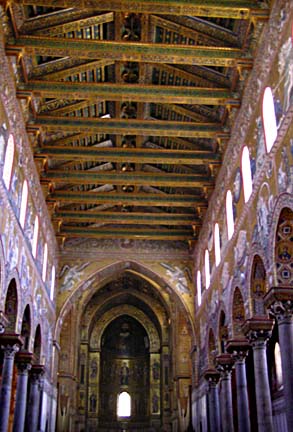|
We arrived in Sicily in the middle of August, 2005, probably the worst time of year to come as it is the height of the tourist season and normally has the hottest weather. We did find all the tourists (mostly Italians on holiday) but the temperatures weren’t too bad (low 30s C; low 90s F). The Italians seem to be in love with Sicily, probably because it is so hot and it has lots and lots of beaches.
We started our tour along the east coast, wandering around Mt. Etna for a day (photo below). Etna is the largest live volcano in Europe and one of the world’s most active.
|
|
The latest eruption was in 2002 and we were hoping another would hold off for a few more days. We drove up the north slope, then around the east side and up the southern slope as far as the road goes. Then we hopped on a cable car to take us near the crater. It is all lava up here, with just some sparse ground cover that has recently taken hold. The area is used for skiing in the winter and the somewhat melted lift towers still stand alone and blackened, a reminder of the ever-present danger. A new lift has been built since then.
|
|
Catania was our next stop, a bustling and energetic port city a bit south of Mt. Etna (but close enough to have been flattened by the eruption in 1669). The central square, Piazza del Duomo, has recently been
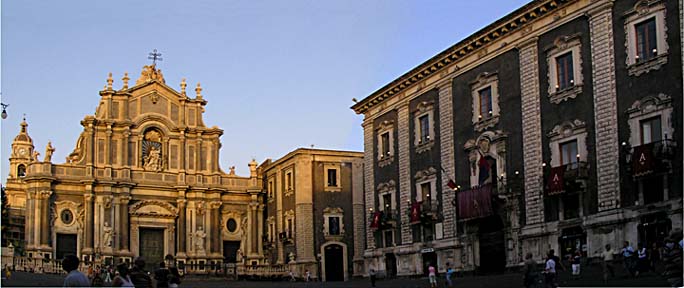 |
declared a UNESCO World Heritage Site due to its unique baroque style, with the cathedral fashioned with a marble facade and surrounding buildings all made of lava and limestone (photo above). What we found most memorable was the evening walk, when everyone was out, now that it was a bit cooler, walking up and down the main street of the town.
|
We headed south and quickly ran into our first (of many) encounters with seaside traffic. This happened to be a Sunday and we think all of Catania was heading to the beach for the day. Not being beach-aholics, we instead turned inland to visit Pantalica, a gorge full of natural caves that were turned into tombs for some 5000 people from the 13th to the 8th centuries BC. The site required us to walk in several kilometers to see the caves. We didn’t get far enough to see the most impressive ones, but could see the canyon walls dotted with the caves (photo right). There were lots of people there, but most had come to spend the day in the cool stream, rather than looking for tombs!
We kept heading south, expecting that we would find hotels or camping on the south coast. Well, we found lots of people at the beach, but no hotels or camping! So back north a bit until we found one.
|
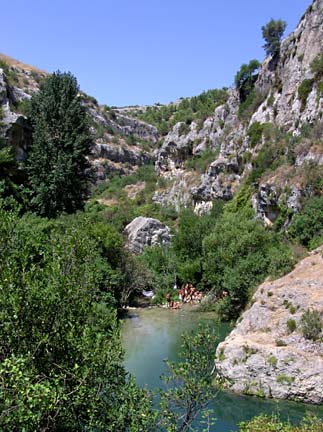
|
|
|
|
The Villa Romana de Casale near Piazza Armerina was our next stop, to see the ruins of this Roman Villa, built in the 3rd century and one of the few relics of Roman Sicily. Evidently the villa was buried in a 12th century flood and remained hidden until the 1950s. Because of this, the mosaics in the villa have been well preserved (photo left). They believe the villa may have been some type of hunting lodge as many of the mosaics depict wild animals and hunters. As the roof and most of the walls were destroyed long ago, most of the mosaics are enclosed with clear plastic wall and roofs (which gives the site a greenhouse effect which is a bit bit stifling on a hot day!). However, even though they are covered, they are not kept clean and unfortunately, the dust and dirt collected on them reduces their original vibrancy and appeal (we increased the contrast on the photo to bring out the colors). Nevertheless, it is a beautiful site and a wondrous display of original mosaics.
|
|
|
|
Back down to the coast, this time to the Valle dei Templi near Agrigento. Here the ruins of several Greek temples from around the 6th to the 4th centuries BC stand boldly on the hilltops. The most well preserved, the Temple of Concord, was later transformed into a church in the 6th century AD, which probably accounts for its prime condition. The Temple of Hercules (photo above) lay in ruin until 1924 when 8 of its columns were raised to reveal that the structure was about the same size as the Parthenon. Several of the structures were surrounded by scaffolding while we were there, but we weren’t sure if they were doing restorations or if the scaffolding was supporting them. Either way, it was a bit disappointing as the overall effect of the massive structure is diminished. Oh well.
|
|
|
Onward to Selinunte to another site of Greek ruins. Here the city of Selinunte sat on the hills above the sea, with several huge temples and the acropolis, now all in ruins. One of the temples has been partially rebuilt and is truly a stunning site (photo right). The ruins cover quite a large area so it is a bit of a hike, but well worth the effort (or, you could take the electric train for €12). We waited until late in the day when it wasn’t so hot and had a nice walkabout.
|
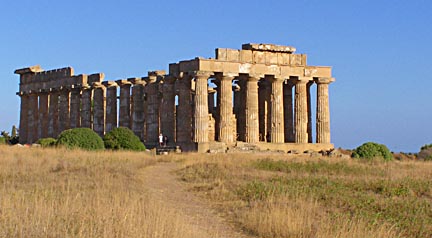
|
|
Between these coastal visits, we headed inland, to get a flavor of the interior (and to get away from the heat a bit). Most of the interior is hilly or mountainous, and much of it is under cultivation, particularly the hills and valleys. It is a beautiful landscape, full of variety and color, with small villages and farms to be found occasionally. Below is a photo of one such valley, picturesquely situated below the craggy mount.
 |
As there are few large cities, we found no hotels or places to camp. So each night we dutifully headed back to the coast where the tourists are to be found. One day as we stopped for a break, a driver who spotted us pulled over for a conversation about the bike. Unfortunately it was more pantomime than talking, but he was really impressed with the bike (and that we were from America!). This was just one of the many friendly encounters we had while on the island. We were constantly being hailed by other drivers and people on the street, as we seemed to create quite a stir wherever we went.
 Driving along the west coast of the island was a bit of a disappointment as the landscape is rather flat and nondescript. The available road is inland from the sea, so the sea is not visible either. We passed through the town the Marsala (famous for its sweet dessert wine), then on to Trapani, a huge sprawling city that was once a small Arab fishing village. We climbed to the top of Mt. Eryx which seems to jut up dramatically from the flatland to the south and west of it. From the top we had a fantastic view of Trapani and the offshore islands (photo above - the old fishing village is on the small spit of land that juts into the sea). Driving along the west coast of the island was a bit of a disappointment as the landscape is rather flat and nondescript. The available road is inland from the sea, so the sea is not visible either. We passed through the town the Marsala (famous for its sweet dessert wine), then on to Trapani, a huge sprawling city that was once a small Arab fishing village. We climbed to the top of Mt. Eryx which seems to jut up dramatically from the flatland to the south and west of it. From the top we had a fantastic view of Trapani and the offshore islands (photo above - the old fishing village is on the small spit of land that juts into the sea).
|
Now on the north coast, we tried to find someplace for the night but everything was booked. So into the hills we headed, hoping to find someplace to lay our heads for the night. The next morning we headed into Monreale to visit the cathedral there, with its unique Norman-Arab architecture. The city traffic was a zoo, but the locals were friendly and helpful in trying to get us to the cathedral. The interior of the cathedral is quite unique (photo right), fully lined with golden mosaics depicting the stories of the New Testament. The floors and lower walls are rich with Arab mosaics in intricate geometric designs. The ceiling is wooden-beam constructions, painted and gilded. The overall effect is quite stunning and worth the trouble getting there!
We skirted Palermo as the big city in the August heat was more than we could bear. And after our experience in the coastal towns to the northwest, we decided we would stay inland for a few days. We were rewarded with many mountain roads, full twists and turns that kept our average speed quite low. But it is a beautiful area, the western parts being more arid and sparse while the eastern areas were more wooded.
|
|
|
|
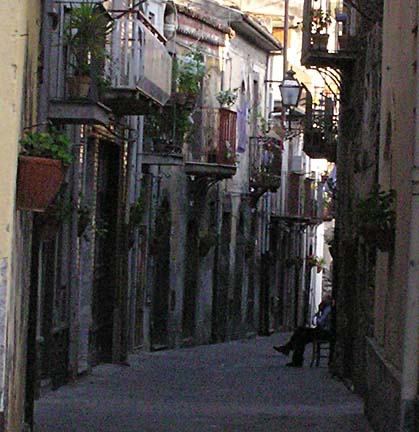
|
One night found us in Randazzo, north of Etna, where the city appeared to be made out of lava. The streets were lava blocks, the churches were made of lava, the walls and the houses were lava. Use of local material was definitely the theme here. And it probably reminds everyone on a daily basis just how real the danger is, though this side has not seen much activity in many decades. This town, like many Sicilian towns, is a maze of small, narrow alleyways, where people live. The photo at left is one example, with an old man sitting outside in the shade.
|
|
Out of Randazzo we headed north across a valley where they were growing some beautiful peaches (and everyone was selling them by the side of the road). If we could have figured a way to strap on a box of them, we would have. Then we went into some very rugged mountains which provided us with some great views of Etna (photo below).
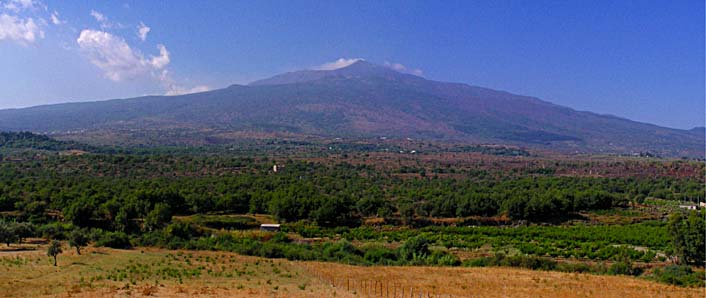 |
We climbed to the summit at a chilly 3676 feet, then plunging to the sea on the other side, we found ourselves once again on the flatlands, passing through seaside villages full of tourists. We decided it had been a good idea to go inland rather than ride along the coast.
We had a great stay in Sicily, enjoying the people, the scenery and the food. The driving is a bit wild at times, with everyone doing as they please. But we soon got the hang of it and were parking where we wanted, forcing our way into traffic, honking when appropriate, and passing over double lines (but only when safe to do so). However, we haven’t quite graduated to passing the car that is passing another, though we saw quite a bit of that maneuver. We’re glad we came and would recommend the island to others with an adventurous nature.
For more pictures from Sicily, see the Sicily Slide Show.
|

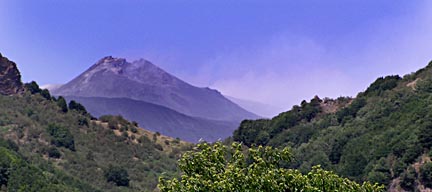


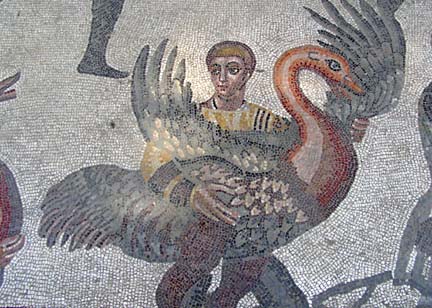
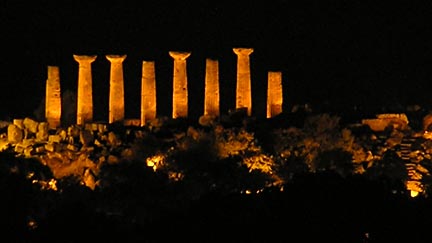


 Driving along the west coast of the island was a bit of a disappointment as the landscape is rather flat and nondescript. The available road is inland from the sea, so the sea is not visible either. We passed through the town the Marsala (famous for its sweet dessert wine), then on to Trapani, a huge sprawling city that was once a small Arab fishing village. We climbed to the top of Mt. Eryx which seems to jut up dramatically from the flatland to the south and west of it. From the top we had a fantastic view of Trapani and the offshore islands (photo above - the old fishing village is on the small spit of land that juts into the sea).
Driving along the west coast of the island was a bit of a disappointment as the landscape is rather flat and nondescript. The available road is inland from the sea, so the sea is not visible either. We passed through the town the Marsala (famous for its sweet dessert wine), then on to Trapani, a huge sprawling city that was once a small Arab fishing village. We climbed to the top of Mt. Eryx which seems to jut up dramatically from the flatland to the south and west of it. From the top we had a fantastic view of Trapani and the offshore islands (photo above - the old fishing village is on the small spit of land that juts into the sea).
